Locked between Georgia, Aserbeidschan, and Turkey with Iran as the only exit, 5000 years of Armenia's history are engraved in the landscape as are 100 years of the worst losses of people and land, survived by resistance, perseverance and will to live.
|
 |
 |
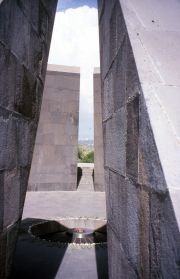 |
 |
 |
 |
 |
 |
Tsitsmerkaband, the eternal fire of memory of the Armenian Genocid
 |
 |
Since its existence Armenia was the object of jealousies of political powers. With defence and resistance it saved its identity, surviving Sowjet rule, even the attempt of extermination, feigned by the Young Turks to be opposed to the idea of an Turkic empire from the Mediterranean to Aserbeidschan, Turkmenistan, Usbekistan, even to China. The Genocide is omnipresent. In front of my hotel in Erevan the Ararat arises, symbol of the Armenian people since the time of Noah - on the other side of the border. In the Armenian Genocide Museum photos remind of the Holocaust. The Armenian statistics speak of 1 1/2 million killed, until now the Turkish state didn't take the responsibility. Behind the Armenian-Turkish border below the monastery Chor Virap guards the Ararat. It conserves the memory of the first Katholikos St. Gregory, the Enlightener, who introduced (3rd c.) the Armenian-apostolical Christianity, the religion of the state until today. The thirst for knowledge led to the development of the Armenian characters (4th c.). The Matenadaran in Jerevan shows the beautiful manuscripts from Europe and Asia. In the face of the Ararat shine the ruins of Zvartnoz, once the seat of the Katholikos, in this undescribable light of the early morning. In the cathedrale of Etschmiatsin, the religious center of the country, seat of the Katholikos (since the 15th c.), the superbly decorated and painted interior betrays its Persian origin. In Sowjet times limited to a minimum of administration and teaching activities, it is faced with the task of Re-Christianization after 70 years without religion. The church is present in the administration of the state, participating in all social programs - so a priest. Religious instruction is taught by secular teachers because of lack of theologians. Non-Christian ethnic groups have a schoolsystem in their own and the Armenian language, their curricula have to be approved by the state.
|
|
| Favourite spots: |
 |
 |
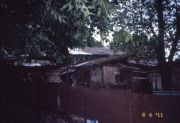 |
 |
 |
 |
 |
 |
Stepanakert, relicts of war
 |
 |
12% of the population are counted as rich, of the rest 88% live 4% under the poverty level. Poverty is relativ, different in the countryside and in town. A disastrous earthquake (1989) destroyed e.g. Gjumri and the neighbouring villages, tore open the hills. Reforestation now supports the mountains. The war against Aserbeidschan (1988) caused not only devastation as in Stepanakert, the capital of Berg Karabach, but also the loss of people as in the totally ruined Schuschi. In Stepanakert the head of the division Planning in the Department of Tourism says, the top priority were the restoration respectively reconstruction of cultural assets and the development of routes to reach them. The financial crisis (1990s) led to the emigration of qualified personnel and academics, who now are missing. Education leaves much to be desired. 70 years of Sowjet rule meant the loss of cultural assets. But the major damage was caused by the life under a dictatorship, permitting no individuality.
|
|
| What's really great: |
 |
 |
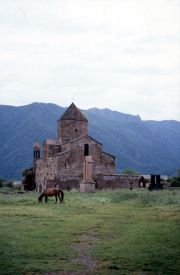 |
 |
 |
 |
 |
 |
The basilica in the village of Odsun
 |
 |
The majority of the people is apparently missing initiative and creativity, but there are exceptions. The mothers of the children, visiting Khndzoresk (the cave village), had an education, but one: I have 6 children, but the state doesn't help me. A Diaspora-Armenian gave Vank a school among other things. Who wants to start e.g. a sheep farm, gets money when he asks, but nobody asks. In the beautiful basilica (6th c.) in Odsun the priest sells calenders and postcards. He has to pay with his own money for his social work. A couple of former teachers owns the B&B. She keeps the house, he has a farm. It rains cats and dogs. The villagers don't pave the muddy roads. To promote tourism isn't in their heads. In Ashtarak the owner of an old house (1837) studied economics, worked in a company for road construction, now cooks healthy food for tourists. The manageress of the restored old part of Dilijan has been an actress, a waitress, a head waitress, finally a manageress for 40 employees.
|
|
| Sights: |
 |
 |
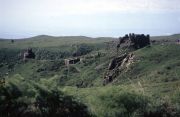 |
 |
 |
 |
 |
 |
Amberd, the fortress, and the small basilica
 |
 |
It is to talk of the beauties, the qietness, and the imperturbability of the country. In the nearly treeless, wide, mountainous landscape, its character lended by agricultur and stock farming, shepherds live in abadonned villages and yurts on the meadows of the village community.
Above a racine stands the fortress Amberd (9th c.) and on the rocky cap at the top of this three-cornered cone the small, dark church, where the deacon sang. Outside lizards, snakes, small scorpions lead an undisturbed life and are treated with consideration. The medieval “Monastery of the Psalms” Saghmossavank above a breathtaking deep ravine is a mystic place, whose impact you can't elude. The little toy church Karmravor (7th c.) in Ashtarak is one of the smallest Armenian churches, built with love, insisting defiantly on its significance.
Below the Selim Pass the Selim Carawanserai (1332) is situated, according to an inscription in Armenian and Arabic language, an important station an the Silk road.
|
|
| Accommodations: |
 |
 |
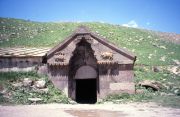 |
 |
 |
 |
 |
 |
Selim caravanserai on the silk road, on the right side the earth house of the host
 |
 |
1. Hotel Ani Plaza
Ani Plaza Hotel CJSC
19 Sayat-Nova Ave., 0001 Yerevan, Republic of Armenia
Tel.:+374-10-594577 Fax:+374-10-565343
- very central
2. Hotel Mirhav
Goris, Syunik region,
Republik of Armenia
Maschtozi Str. 100
Tel: +374 (284) 24612
Keine Website.
3. Hotel Armenia
Stepanakert NKR
Renaissance Square
20-th February STR. Building 4
Tel: (+374) 47 94 88 02
Fax: (+374) 47 95 09 10
www.armeniahotel.am
4. Hotel Basen
A. Manukyan 2, Sisian,
Armenia 3502
Telephone: 093/434-727
http://www.basenllc.com
- has the Character of a private home
. Hotel Bohemyan Resort
Sevan near the peninsula,
Armenia
Tel.: +374 261 2 58 85
www.bohemianresort.am
- faceless, but has all what is required
6. Odsun BB (Sergo BB)
Armenia, Lori region,
Vilage Odsun
Keine Web
7. Hotel Arax
31 Gorki str., Gyumri, Republic of Armenia, 377501
Phone: (374312) 5-11-99
http://www.arakshotel.am/
- old-fashioned
|
|
| Nightlife: |
 |
 |
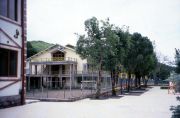 |
 |
 |
 |
 |
 |
Vank, the present of a rich, but modest Russian Diaspora Armeian
 |
 |
Literature
- G. Sinoué, Erevan, Édition Flammarion 2009, hauntingly described the Genocide of the Armenians by the Young Turks.
- O. Mandelstam, Die Reise nach Armenien, Bibliothek Suhrkamp 2010 (French title: Voyage en Arménie)
- Armenien - 5000 Jahre, Kultur und Gechichte (Bochum Katalog), Wasmut Verlag (only in German)
- Tessa Hoffmann, Annäherung an Armenien; Armenien - Stein für Stein; Armenien - Land und Leute (only in German)
- Gerard J. Libaridian (ed.), A Crime of Silence: The Armenian Genocide (1985; originally published in French, 1984), prepared by the Permanent Peoples' Tribunal.
- H.F.B. Lynch, Armenia, Travels and Studies, 2 vol. (1901, reprinted 1990), a classic traveler's account.
- Gerard J. Libaridian (ed.), A Crime of Silence: The Armenian Genocide (1985; originally published in French, 1984), prepared by the Permanent Peoples' Tribunal.
- David Marshall Lang, The Armenians: A People in Exile (1981)
|
|
| Hangouts: |
 |
 |
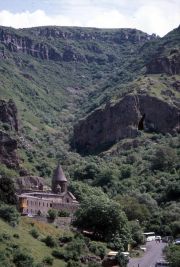 |
 |
 |
 |
 |
 |
Geghard, the cave monastery
 |
 |
What stays in mind is the impression of an isolated, secure, and quiet country, whose people in and outside the country mostly stay together, and whose ethnic groups and religious minorities live in peace with each other. At stake is the instauration of Christianity and the cultural heritage, the improvement of the social and economic condition, the reconstruction after the human, material and scenic destruction.
|
|
| Restaurants: |
 |
 |
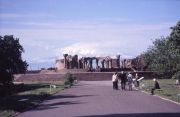 |
 |
 |
 |
 |
 |
Zvartnoz in the face of the Ararat
 |
 |
I ate very good in nice restaurants, but I forgot to ask for the names
and business cards were in Armenian language. I travelled with a guide and was lazy, but there are at least ...
Elen
Tel: (+374 10) 534221, 538287
Address: 9 Mashtots Ave., Yerevan, ARMENIA
and
Hrispime Tumanjan
st. Sashumjan, Ashtarak, Armenia
|
|
| Other recommendations: |
 |
 |
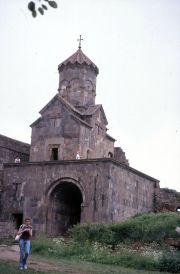 |
 |
 |
 |
 |
 |
Tatev, the mobastery for a thouand monk
 |
 |
The new road through the forests of the deep Vorotan Canyon in Berg Karabach leads to the monastery Tatev (10th c.), built at the edge of nothing on a naturtal fortress of rock, a place of learning and religious reflection.
The monastery Ganzasar (13th c.), a small enclosure isbuilt on a promontory. The outside walls of the church and its spire are an encyclopaedia of religious symbols. Noravank (12th c.), the New Monastery, formerly a great, cultural center, built at a nearly inaccessable position in an impressiv natural setting, using the protection of the natural circumstances. It has a burial chapel with a beautiful facade. The cave monastery Geghard is a phenomen. Situated above a deep ravine, only a small part is built in front of the rock wall, the bigger part digged into the rock from above: Fascinating the elaborate system of lighting and incredible acoustics and the outstanding stonemasonry witnessed by the fine adornments of the outside.
|
|
Published on Tuesday May 29th, 2012
|
|
 Publish on Facebook
Publish on Facebook
|
Thu, Aug 16 2012 - 09:40 AM
 by bootlegga
Sun, Jul 01 2012 - 10:20 AM
 by marianne by marianne
| Christl, What an interesting trip! and what an informative report. A great read! |
Wed, Jun 06 2012 - 01:35 AM
 by louis by louis
| Christl, very good report. In my memories Armenian are amongs the friendliest people in the world and I think that you have also this impressions. Nagorno Karabakh is also a very interesting placesto visit. |
Tue, Jun 05 2012 - 07:14 AM
 by horourke by horourke
You have rekindled for me a very emotional memory of a night spent listening to Armenian music in Brussels. Your opening photograph of the Eternal Flame brings the long heart-rending history of the country alive/.
You have written a report that is intensely interesting for me. |
Tue, May 29 2012 - 12:57 PM
 by pesu by pesu
| Thanks, Christl, for giving us these special impressions and many infos from a not often visited country by your very personal descriptions and the fine photos! |
| Information: |
| Login if you are a member, or sign up for a free membership to rate this report and to earn globo points! |
|
| Syria |
|
|
|
|
|
|
|
|
 |
| United Kingdom |
|
|
 |
| Vietnam |
|
|
|

|
